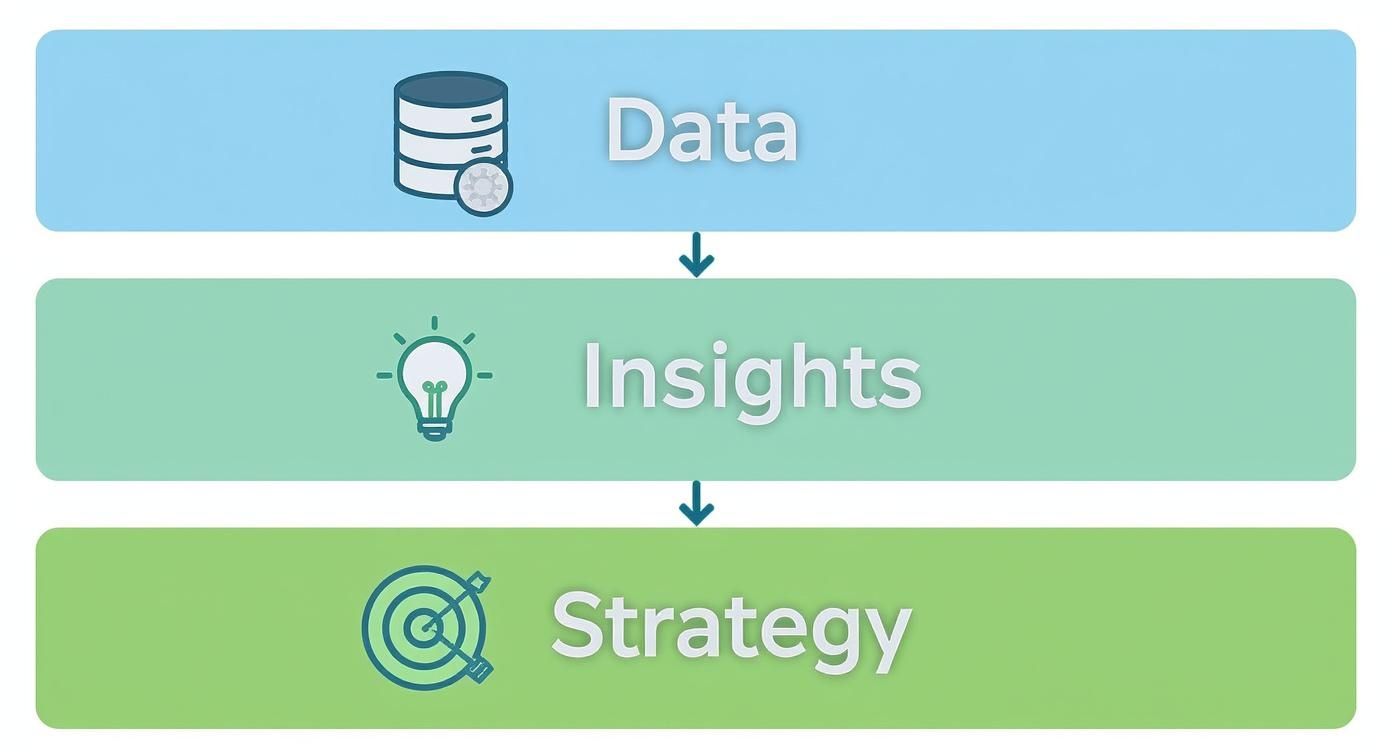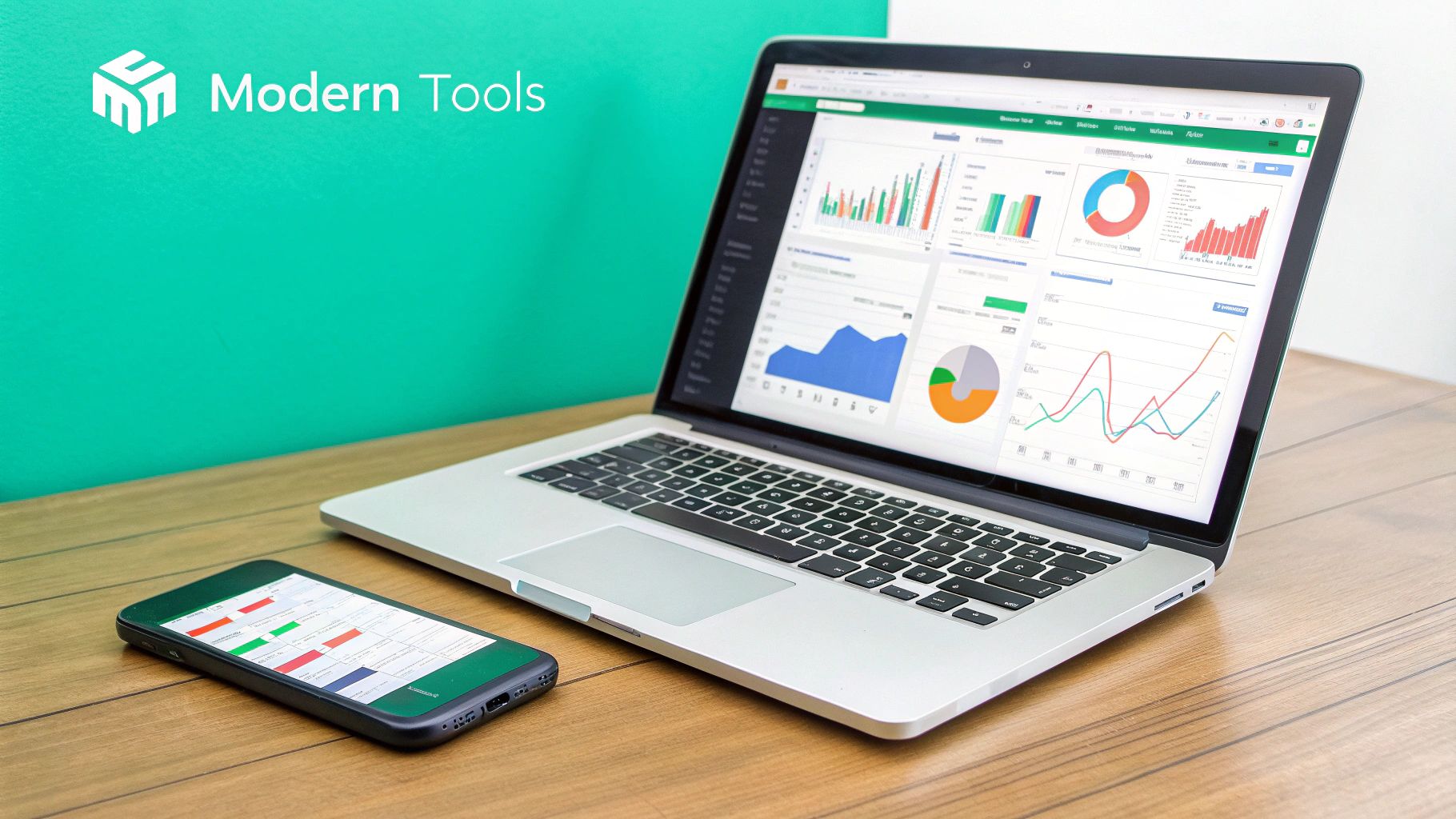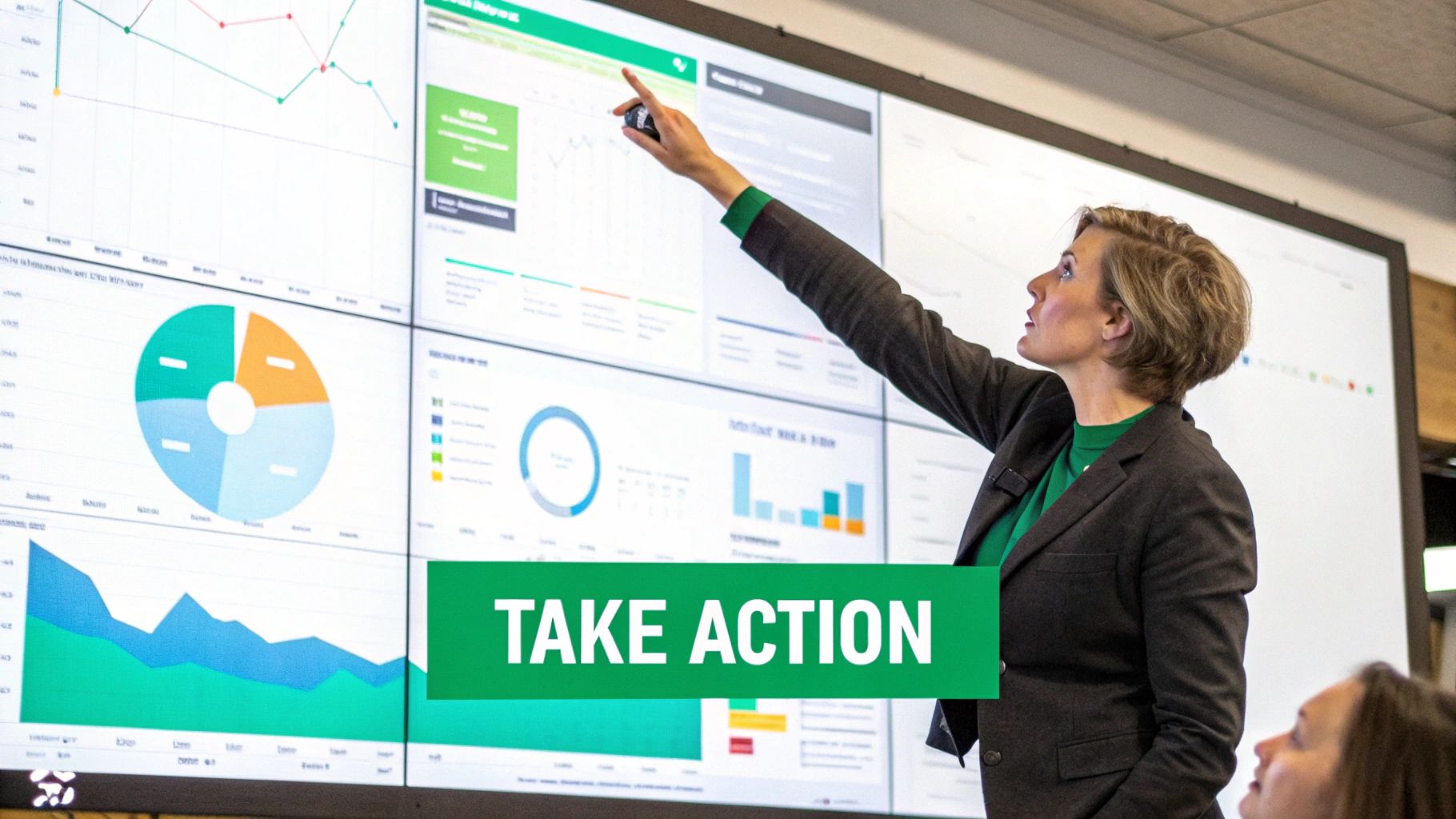What Is Customer Profiling and Why It Matters
Customer profiling is all about painting a detailed picture of your ideal customers by looking at what they have in common. It’s the process of ditching the guesswork and using real demographic, psychographic, and behavioral data to figure out who your customers are, what they need, and how they make decisions. Think of it as a compass for your entire business strategy.
What Is Customer Profiling Really About?
Ever tried to hit a target in the dark? That’s what marketing, sales, and product development can feel like when you don’t have a solid grasp of your audience. Customer profiling is how you turn on the lights. It's a strategic way to build a detailed, human-focused picture of the people most likely to buy from you and become loyal fans of your brand.
This isn’t about boxing people into rigid stereotypes. Instead, it’s about spotting the common threads and patterns among your best customers so you can guide your decisions with actual data. You’re turning abstract market segments into tangible, relatable groups of people. At its heart, customer profiling is about getting to know your ideal customers, a process that goes hand-in-hand with learning how to create buyer personas that fuel B2B growth.
A customer profile is a document that contains key information about your ideal customer. You can use it as a strategy guide to creating personalized experiences.
Ultimately, profiling gives you a solid foundation for everything you do. It empowers you to:
- Personalize Marketing: Create messages that truly connect with specific groups.
- Refine Product Development: Build features that solve real customer problems.
- Improve Customer Service: Anticipate what your customers need and offer proactive support.
When you know exactly who you're talking to, every single interaction becomes more effective, efficient, and meaningful. This all starts with collecting and analyzing a few different types of data, which we can break down into core components.
Core Components Of A Customer Profile
To build a complete customer profile, you need to pull together different kinds of information. Each piece of the puzzle gives you a clearer view of who your customer is and what drives them.
| Component | Description | Example Data Points |
|---|---|---|
| Demographic | "Who" your customer is based on objective, statistical data. | Age, gender, income, job title, education level. |
| Geographic | "Where" your customer is located and its influence on them. | City, region, country, climate, urban vs. rural. |
| Psychographic | "Why" they make decisions, focusing on internal traits. | Values, lifestyle, interests, personality, attitudes. |
| Behavioral | "What" actions they take related to your brand or products. | Purchase history, website usage, brand interactions. |
Looking at these four areas together gives you a much richer understanding than any single category could on its own. It's this combined insight that makes customer profiling so powerful.
The Four Pillars of an Effective Profile
Building a customer profile that actually works is a bit like assembling a high-definition photograph from four distinct layers. Each layer adds a different kind of detail, and you only get the full, vivid picture of your customer when you combine them all. If you just rely on one or two, you’re left with a flat, one-dimensional sketch.
These four layers are the essential pillars of customer profiling. Getting a handle on them is the first step to ditching generic assumptions and moving toward a sharp, actionable understanding of your audience.
Demographics: The Who
Demographic data is the most straightforward pillar. It answers the fundamental question: "Who are my customers?" This is the objective, statistical information that provides a basic outline of your audience.
Think of it as the census data for your customer base. It includes quantifiable traits like:
- Age and Gender: Core identifiers that often shape needs and how people prefer to communicate.
- Income and Education Level: Key indicators of purchasing power and potential interests.
- Job Title and Industry: Absolutely crucial for B2B profiling, as it defines their professional world and the problems they face.
But demographics alone can be misleading. Just knowing you have a 35-year-old male customer with a high income doesn't tell you why he buys from you. For that, we need to add the next layer.
Geographics: The Where
The second pillar, geographics, answers a simple question: "Where are my customers located?" You’d be surprised how much of an impact location has on a customer's needs, preferences, and buying habits.
This goes way beyond just a pin on a map. Geographic data considers factors like:
- Country, City, or Region: This affects language, culture, and what services are even available.
- Climate: A huge influence on demand for certain products (think winter coats versus surfboards).
- Urban vs. Rural Setting: This shapes lifestyle, daily commutes, and what people value locally.
For instance, someone living in a dense city center has completely different transportation needs and shopping habits than someone in a quiet suburb.
Psychographics: The Why
Psychographics are arguably the most powerful pillar because they dig into the "why" behind what customers do. This is where your flat sketch gets its personality and depth, revealing the internal motivations that actually drive decisions.
This pillar is all about understanding a person's inner world through their:
- Values and Beliefs: What do they stand for? Are they eco-conscious, family-focused, or always chasing the next innovation?
- Lifestyle and Interests: How do they spend their time and money? What are their hobbies?
- Attitudes and Opinions: How do they feel about your industry, your competitors, or broader trends? Getting these insights is a core part of effective social media reputation monitoring, since online chatter often reveals these exact traits.
Behavioral Data: The What
Finally, behavioral data gives you concrete proof of how customers interact with your brand. It answers the question: "What do my customers actually do?" This pillar grounds all the other data in real-world actions.
This information is pulled directly from their engagement with your business and includes things like:
- Purchase History: What have they bought, how often do they buy, and how much do they spend?
- Website Activity: Which pages do they visit? How long do they stick around? What content catches their eye?
- Brand Interactions: Have they ever contacted support, opened your emails, or engaged with you on social media?
This infographic shows how these pillars of data feed into insights, which then inform your business strategy.

The visualization makes it clear that raw data is just the starting point. Its real value is only unlocked when it’s turned into actionable insights that guide where you're headed.
How Customer Profiling Drives Business Growth
Getting to know your customers on a deeper level isn’t just some feel-good exercise; it’s a direct line to real, measurable business growth. When you ditch broad assumptions for detailed, data-backed profiles, you suddenly unlock the ability to make smarter decisions across the board. This kind of strategic clarity is what separates companies that just tread water from those that consistently scale.
Think about it this way: a generic marketing message is like shouting into a crowded room, hoping someone pays attention. But a message built from a solid customer profile? That’s like having a one-on-one conversation, hitting on a person's specific needs and interests. This precision is why hyper-personalized campaigns see such a dramatic lift in engagement and conversions.
According to Zendesk, 74% of consumers say that hyper-personalization improves their experience with a brand. You simply can't achieve that level of connection without a clear, accurate profile to guide you.
This move from mass marketing to targeted engagement translates directly into a much stronger return on investment (ROI). You stop blowing your ad budget on audiences who were never going to convert anyway and start putting your resources exactly where they’ll make the biggest impact.
Enhancing Product and Service Development
But customer profiling does more than just sharpen your marketing—it fundamentally improves what you sell. When your product development teams can analyze the shared frustrations and goals within your ideal customer segments, they get a clear roadmap for what to build next.
Instead of guessing which features might catch on, you can innovate with confidence. You know you're solving real problems for the people who matter most to your business. This customer-centric approach leads to products with higher adoption rates and a much better fit in the market.
- Solve Real Problems: Profiles shine a light on the daily challenges your customers face, guiding your team to build solutions they genuinely need.
- Prioritize Features: Understand which updates or new features will deliver the most value to your most profitable customer segments.
- Reduce Development Waste: Stop building features that nobody wants, saving a ton of valuable time and resources.
Fostering Unbreakable Customer Loyalty
Finally, you can’t overstate the impact on customer service and loyalty. When your support team understands a customer's history, preferences, and potential pain points, they can provide proactive, empathetic help. This transforms customer service from a reactive cost center into a powerful engine for retention.
Anticipating needs before they become problems builds a deep sense of trust and appreciation. This is how you create brand advocates who not only stick with you but also sing your praises to others. By applying profile insights, you can improve every touchpoint, from the initial outreach in your B2B lead generation efforts to long-term support.
In the end, customer profiling isn't just about knowing who your customers are. It’s about using that knowledge to build a more successful, resilient, and customer-focused business.
Building Your Profiles with Modern Tools

The days of cobbling together customer profiles with spreadsheets and a bit of guesswork are thankfully behind us. Today, we have a dynamic set of tools that can turn mountains of raw information into crystal-clear, actionable portraits of your audience. This isn't just about being more accurate; it's about creating profiles that evolve in real time.
Social media platforms are ground zero for this shift. Channels like Reddit, X, and LinkedIn have become treasure troves of live customer data. They offer an unfiltered peek into what people are thinking, talking about, and struggling with right now. By tuning into these conversations, you can gather the kind of psychographic and behavioral insights that traditional surveys could only dream of.
The Rise of AI in Customer Profiling
The real game-changer here is artificial intelligence (AI) and machine learning. These technologies are built to sift through massive, complex datasets and spot patterns that would be completely invisible to the human eye. AI doesn't just show you what your customers did yesterday; it helps you predict what they'll do tomorrow.
An AI-driven approach transforms customer profiling from a reactive reporting exercise into a proactive strategic tool. It helps you understand not just who your customers are today, but who they are likely to become tomorrow.
AI-powered tools do the heavy lifting, freeing up your team to focus on strategy instead of getting lost in the data. They can segment audiences with incredible precision, flag high-intent signals, and even spot emerging trends before they hit the mainstream. This is where you find a serious competitive advantage. For a deeper look at this technology, check out our guide to AI lead generation tools.
Core Technologies Powering Modern Profiles
A few key technologies form the foundation of any modern customer profiling strategy. When you bring them together, you create a powerful ecosystem for truly understanding your audience.
- Social Listening Platforms: Tools like Intently monitor online channels for keywords, brand mentions, and competitor chatter, giving you a constant stream of qualitative data.
- Customer Relationship Management (CRM) Systems: Your CRM is the central command for all customer interaction data. It tracks everything from purchase history and support tickets to communication records.
- Website Analytics Tools: Platforms like Google Analytics show you exactly how people behave on your site—what they click on, which pages they linger on, and their path to becoming a customer.
- AI-Powered Data Platforms: These systems are the glue that holds everything together. They pull data from all your other sources and apply machine learning to build rich, dynamic profiles and generate predictive insights.
This tech-driven approach is quickly becoming the new standard. In fact, by 2024, around 42% of marketing leaders were already using AI for tasks like content creation, which relies heavily on a deep understanding of customer profiles. This trend shows just how fast companies are adopting AI to deliver more personal and relevant messages to the right people. You can read more about these marketing trends on Salesforce.
Common Profiling Mistakes You Need to Avoid
Building a customer profile is a massive step forward, but here's the catch: a bad profile is worse than having none at all. It can send your marketing, sales, and product teams on a wild goose chase, burning through time and money.
To make sure your profiling efforts actually lead to growth, you need to sidestep a few common pitfalls.
Creating Overly Generic Profiles
One of the most frequent mistakes is creating profiles that are just too broad to be helpful. A profile for "small business owners," for example, is almost useless. It lumps a tech founder scrambling for venture capital in with a local bakery owner worried about foot traffic. Their problems, budgets, and goals couldn't be more different.
Effective profiles have to be specific. The goal is to paint a clear, focused picture that lets you target with precision. Without that focus, your marketing messages will just be generic noise that fails to connect with anyone.
A profile so broad it speaks to everyone is a profile that ultimately speaks to no one. Specificity is the key to creating a connection.
Relying on Outdated Stereotypes
The next major mistake is leaning on tired stereotypes instead of real, hard data. Cobbling together a profile based on lazy assumptions—like "all millennials love avocado toast"—is a recipe for failure.
Real customer profiling is about digging in and discovering what makes your specific audience tick, not trying to shove them into boxes that were built years ago.
Ignoring Data Privacy and Ethics
In the race to collect information, it's dangerously easy to forget about ethical data handling. People are savvier than ever about how their data is used, and building profiles without being transparent is the fastest way to obliterate trust.
Always be upfront about what you're collecting and why. Following privacy rules isn't just about avoiding fines; it’s a core part of building a healthy, lasting relationship with the people you want to serve.
Treating Profiling as a One-Time Project
Finally, one of the biggest blunders is treating customer profiling as a "set it and forget it" task. Markets shift, new trends pop up, and your customers' needs will absolutely change over time. A profile that was spot-on a year ago could be completely off the mark today.
Your profiles should be living documents. You need to be constantly feeding them new data, listening to feedback, and sharpening your understanding of your audience. This ongoing work is what keeps your entire strategy relevant and aligned with what people actually need right now.
Putting Your Customer Profiles into Action

Creating a detailed customer profile is a great start, but it's only half the battle. A profile sitting in a folder doesn't do much. The real magic happens when you actually use those insights to make smarter decisions about your business. This is where your deep understanding of the customer turns into better marketing, stronger products, and real relationships.
Think of each profile as your strategic roadmap. It doesn’t just tell you who to talk to; it tells you how to talk to them. This opens the door to a level of personalization that generic, one-size-fits-all marketing can never hope to achieve.
For instance, if one of your profiles reveals a segment of your audience is passionate about sustainability, you can start highlighting your brand's eco-friendly practices in your messaging. This simple insight can shape everything from your email subject lines to the visuals in your social media ads, making your campaigns connect on a much deeper level.
From Insights to Impactful Campaigns
Putting your profiles to work means turning all that data into specific, concrete actions across every channel you use. It's about making sure every single touchpoint—every email, ad, and post—reflects what you know about your customer's needs and what they care about.
Social media, in particular, is a goldmine for both gathering these insights and launching highly targeted campaigns. It's a two-way street. You can listen to what resonates with specific profiles and then deliver content that speaks their language. This is more important than ever, as research from 2023 shows 32% of consumers globally now use social media for product research. In fact, about 29% of consumers in markets like the US and UK bought from a brand they first found on social.
Tailoring the Entire Customer Journey
The power of customer profiling goes way beyond your initial marketing campaigns. It should be a guiding force throughout the entire customer lifecycle, from their very first click to long-term support and retention.
By applying profile insights at every stage, you create a cohesive and personalized experience that builds loyalty and turns customers into advocates.
Once you have your profiles built, you can use them to improve key moments in the customer journey. A perfect example is implementing effective customer onboarding best practices. If you know a new customer's technical skill level or their main business goals, you can design a custom onboarding flow that gets them to value faster and sets them up for long-term success.
This kind of proactive, data-informed approach ensures you're not just winning new customers, but building valuable, lasting relationships. Ultimately, putting your profiles into action is the final, crucial step that turns raw data into revenue and loyalty.
Your Customer Profiling Questions Answered
As you start putting these ideas into practice, a few common questions always seem to pop up. Getting these distinctions straight is key to building and using your customer profiles with confidence.
How Is a Customer Profile Different From a Buyer Persona?
Think of it like building a house. The customer profile is your architectural blueprint. It’s all the hard data—the demographics, behaviors, and firmographics that lay the foundation. It’s the objective “what.”
A buyer persona, on the other hand, is the fully furnished and decorated home. It’s the story you build on top of that blueprint, giving the data a name, a face, and a personality. It’s the empathetic “who” your team can really connect with.
How Often Should I Update Customer Profiles?
Customer profiles aren't a "set it and forget it" kind of thing. They’re living documents, not static reports you file away and never look at again. A good rule of thumb is to give them a thorough review at least once a year.
But you’ll want to check in on them more often if you see big shifts in the market, launch a new product, or notice your customer behavior is changing. This keeps your strategy grounded in what’s actually happening right now.
What Are the Best Data Sources for Profiling?
The strongest, most reliable profiles come from a mix of sources. You want to see the complete picture, not just one piece of it.
Start with what you already have: your own internal data from your CRM and website analytics is a goldmine. Then, layer on qualitative insights from customer surveys and feedback from your sales team—they're on the front lines, after all. Finally, zoom out and get the bigger picture with third-party market research to fill in any gaps.
Ready to stop guessing and start knowing who your customers are? Intently uses AI to monitor online channels and find high-intent conversations, giving you the real-time data you need to build powerful, accurate profiles. Discover qualified leads and deep insights at https://intently.ai.
